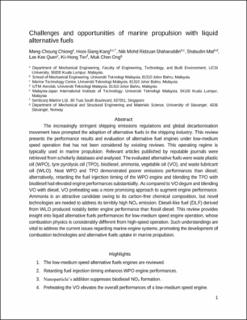| dc.contributor.author | Chiong, Meng-Choung | |
| dc.contributor.author | Kang, Hooi-Siang | |
| dc.contributor.author | Shaharuddin, Nik Mohd Ridzuan | |
| dc.contributor.author | Mat, Shabudin | |
| dc.contributor.author | Quen, Lee Kee | |
| dc.contributor.author | Ten, Ki-Hong | |
| dc.contributor.author | Ong, Muk Chen | |
| dc.date.accessioned | 2022-02-15T09:17:39Z | |
| dc.date.available | 2022-02-15T09:17:39Z | |
| dc.date.created | 2022-01-27T09:26:21Z | |
| dc.date.issued | 2021-06 | |
| dc.identifier.citation | Chiong, M-C., Kang, H-S., Shaharuddin, N.M.R., Mat, S., Queen, L.K., Ten, K-H., Ong, M.C. (2021) Challenges and opportunities of marine propulsion with alternative fuels. Renewable & Sustainable Energy Reviews, 149, 111397 | en_US |
| dc.identifier.issn | 1364-0321 | |
| dc.identifier.uri | https://hdl.handle.net/11250/2978990 | |
| dc.description.abstract | The increasingly stringent shipping emissions regulations and global decarbonisation movement have prompted the adoption of alternative fuels in the shipping industry. This review presents the performance results and evaluation of alternative fuel engines under low-medium speed operation that has not been considered by existing reviews. This operating regime is typically used in marine propulsion. Relevant articles published by reputable journals were retrieved from scholarly databases and analysed. The evaluated alternative fuels were waste plastic oil (WPO), tyre pyrolysis oil (TPO), biodiesel, ammonia, vegetable oil (VO), and waste lubricant oil (WLO). Neat WPO and TPO demonstrated poorer emissions performances than diesel; alternatively, retarding the fuel injection timing of the WPO engine and blending the TPO with biodiesel had elevated engine performances substantially. As compared to VO degum and blending VO with diesel, VO preheating was a more promising approach to augment engine performance. Ammonia is an attractive candidate owing to its carbon-free chemical composition, but novel technologies are needed to address its terribly high NOx emission. Diesel-like fuel (DLF) derived from WLO produced notably better engine performance than fossil diesel. This review provides insight into liquid alternative fuels performances for low-medium speed engine operation, whose combustion physics is considerably different from high-speed operation. Such understandings are vital to address the current issues regarding marine engine systems, promoting the development of combustion technologies and alternative fuels uptake in marine propulsion. | en_US |
| dc.language.iso | eng | en_US |
| dc.publisher | Elsevier Ltd. | en_US |
| dc.rights | Attribution-NonCommercial-NoDerivatives 4.0 Internasjonal | * |
| dc.rights.uri | http://creativecommons.org/licenses/by-nc-nd/4.0/deed.no | * |
| dc.subject | energi | en_US |
| dc.subject | drivstoff | en_US |
| dc.subject | brennstoff | en_US |
| dc.title | Challenges and opportunities of marine propulsion with alternative fuels | en_US |
| dc.type | Peer reviewed | en_US |
| dc.type | Journal article | en_US |
| dc.description.version | acceptedVersion | en_US |
| dc.rights.holder | © 2021 Elsevier Ltd. All rights reserved. | en_US |
| dc.subject.nsi | VDP::Teknologi: 500 | en_US |
| dc.source.pagenumber | 16 | en_US |
| dc.source.volume | 149 | en_US |
| dc.source.journal | Renewable & Sustainable Energy Reviews | en_US |
| dc.identifier.doi | 10.1016/j.rser.2021.111397 | |
| dc.identifier.cristin | 1990959 | |
| dc.source.articlenumber | 111397 | en_US |
| cristin.ispublished | true | |
| cristin.fulltext | postprint | |
| cristin.qualitycode | 1 | |

